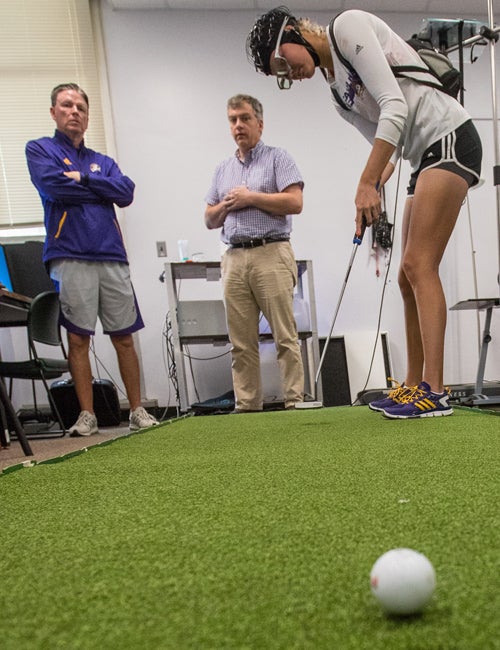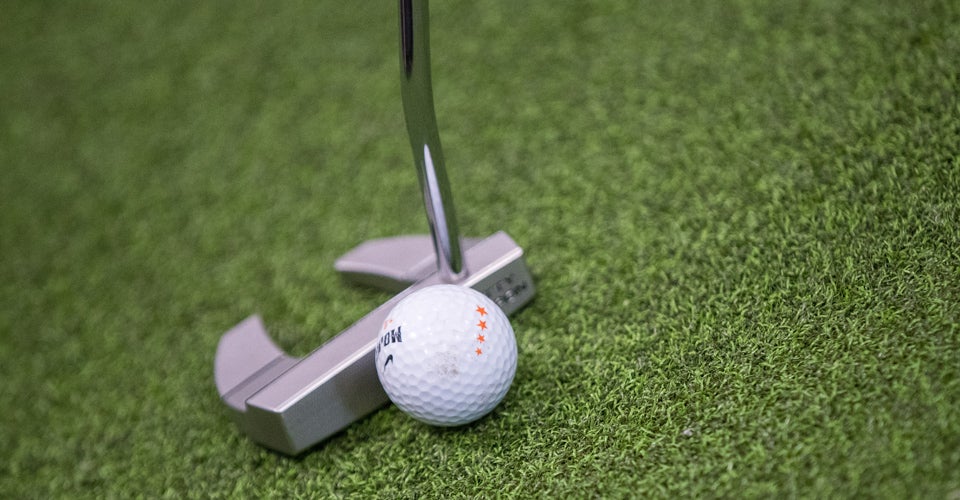STEADY EYES
Putting research aims at insights to brain-eye connection
If you’ve ever been to a golf course while a lesson was going on, you’ve probably heard this exchange:
Golf pro: Keep your eye on the ball.
Golfer: Why? The ball’s not going anywhere.
Now, researchers at East Carolina University are putting numbers to that instruction of keeping your eye on the ball – a steady eye.
Nick Murray, an associate professor of kinesiology, and Chris Mizelle, an assistant professor of kinesiology, are studying the phenomenon of eye movement – a steady, or quiet, eye – before the start of a self-timed movement.
The stability of eye movements impacts how athletes use visual information to guide the execution of their actions. A quiet eye immediately before the start of movement typically results in performance success. Researchers have proposed that quiet eye duration reflects the organization of neural networks controlling a planned motor response.
Murray and Mizelle want to determine the brain mechanisms involved when an expert golfer has a steady quiet eye. The findings could have applications to other areas where motor performance and visual control are important, such as training surgeons or rehabilitation from stroke impairments.
Toward that end, Murray, an expert in psychophysiology, and Mizelle, who studies motor control and neuroscience, are testing golfers while they putt using a special pair of glasses that tracks eye movement and an electroencephalography skullcap with 64 sensors that measure brain activity.
“We can record information from basically the entire surface of the brain,” said Murray.
They began the study in the fall. Thus far, they’ve found that steadier eyes lead to more made putts.

Women’s golf team member Lisa Petterson putts in a lab as researcher Nick Murray and women’s golf coach Kevin Williams watch. Murray and fellow kinesiology faculty member Chris Mizelle are studying the effect of steady eyes on putting performance.
Study participants include members of the ECU women’s golf team and regular students. Their golf skills range from beginner to expert.
“The novice, their eye movements are all over,” Murray said. “They do not know they’re doing it. The minute you do that, you start moving the body.” Often that movement is in the direction of where they think the ball is going to go. Other times, eyes follow the putter going back and through. Either way, the result is poorer performance, Murray said.
Better players, on the other hand, tend to look at the ball longer and with a steadier gaze.
Recently, some golf teachers have advocated looking at the hole rather than the ball while putting. World No. 6 golfer and two-time major champion Jordan Speith sometimes putts this way. Either way, the key is steady eyes, Murray said.
“Theoretically, it would (work the same way, whether focusing on the ball or hole),” Murray said. “It’s more about steady vision control and less about where that is.
“Other people have studied this phenomenon, but we still don’t understand the mechanism behind it or what’s going on in the brain,” Murray said. “What folks haven’t focused in on is how the brain controls that motor function.”
“Looking at how the brain and the eyes work together – there’s a lot of application in that,” Mizelle said.
As ECU women’s golf coach Kevin Williams watched student-athlete Lisa Pettersson putt in the lab, he said the research and the data he has seen so far could prove useful on the course.
“If it helps her make one more putt per round, that’s better for us,” he said.
Did Pettersson think knowing where her eyes were looking would help her make more putts?
“Definitely,” she said.
Graduate students Kellen Altman and Caitlin Melton and undergraduates Alex Shaver and Jaclyn Farrior are assisting with the project.

